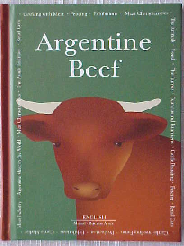 By Nicholas Li
By Nicholas Li
Argentina is no stranger to inflation. Foreign investors, labor unions, and international financial institutions like the IMF and World Bank have always kept a close eye on inflation and pressured the government to control it. Argentina’s ultimately disastrous decision to adopt a currency board and peg the peso to the dollar in 1991 was born out of a desire to bring inflation under control. In Latin America, Ecuador has dollarized for similar reasons. Argentina is much more like Ecuador than El Salvador, the other country that dollarized recently to promote closer economic ties with the United States and improve financial intermediation.
So why would the Argentine statistical service INDEC suddenly decide to revamp the way it measures inflation in February of this year? Surely by now they would have figured out a consistent methodology that accurately reflects inflation pressures in the economy? And how is this related to the Kirchner government’s deicision to restrict exports of beef, but not soy?
 The key to understanding the Kirchner government’s inflation policies is to grasp the historical origins and manifestations of the distributive conflict in Argentina. Argentina has historically had strong unions and a powerful, organized lobby on behalf of urban workers. These workers have interests that often conflict with those of the country’s agricultural elite. Yet the government has almost never engaged in direct redistribution. Land reform has never been taken seriously. While tax levels are well within international norms and the government used to have generous welfare programs by Latin American standards, tax evasion has become a national sport, with up to 40% of the value of potential tax revenue lost due to tax evasion . In 2005 this even resulted in the spectacle of tax Santas . As result the welfare state has been reduced dramatically.
The key to understanding the Kirchner government’s inflation policies is to grasp the historical origins and manifestations of the distributive conflict in Argentina. Argentina has historically had strong unions and a powerful, organized lobby on behalf of urban workers. These workers have interests that often conflict with those of the country’s agricultural elite. Yet the government has almost never engaged in direct redistribution. Land reform has never been taken seriously. While tax levels are well within international norms and the government used to have generous welfare programs by Latin American standards, tax evasion has become a national sport, with up to 40% of the value of potential tax revenue lost due to tax evasion . In 2005 this even resulted in the spectacle of tax Santas . As result the welfare state has been reduced dramatically.
Instead of direct redistribution, Argentine governments have tended to adopt measures that are highly distorting to the economy. Their favorite tools have been maintaining an overvalued exchange rate, using inflation and government debt to fund welfare programs, and direct price controls and export bans. An overvalued exchange rate makes Argentina’s exports less competitive and its imports more competitive. The peso-dollar peg is one manifestation of this tendency – when Brazil devalued the Real in the late 1990s, this significantly worsened the trade balance in Argentina, contributing to the crisis. Why does overvaluation placate the urban, industrial interests? Historically, Argentine industry was guided by import-substition policies so industrial products were consumed in the home market and not exported abroad. Raw materials and machinery were imported, so a strong peso made the inputs cheaper in terms of pesos while having no effect on the peso price of output, boosting profits in the industrial sector and allowing for higher worker salaries. Simultaneously, Argentine exports – wheat and beef primarily – were diverted towards the domestic market by the uncompetitive exchange rate. Cheaper food prices and cheaper imports boosted the real incomes of urban workers, so an overvalued exchange rate acted as an indirect redistributionary mechanism from the agricultural elite to the urban classes.
When this was not sufficient, the government resorted to printing more money and running budget deficits. Rather than face the difficult prospect of enforcing tax compliance (not popular with any social class) or directly redestributing resources through the tax system, the government would try to have it all. This could not last forever (as we saw with the recent debt default under the Kirchner government) but the tendency has always existed in the Argentine political system. The inflation and foreign debt burden could be ameliorated to some extent by an overvalued currency, but when this was insufficient the government sometimes resorted to direct price controls.
The final element of the Argentine indirect redistribution package is price controls and export restrictions. Price controls, popular around the world in the 1970s as a measure to deal with inflation, are never very effective – in extreme cases, they are bypassed entirely by black markets, while in milder cases they tend put a cap on inflation for a limited time and then burst when the pent-up economic pressures become too great. Yet they are very popular politically. Instead of making tough choices to rein in inflation by slashing deficits and reducing the rate of money creation, governments can blame speculators, hoarders, and price-gouging businesses to win votes from consumers. In Argentina, this has often meant rent controls, regulating utilities prices, and attempts to keep the prices of food low.  One thing that makes Argentina somewhat unique is the importance of beef in the basic consumption basket – while in many countries meat is a luxury and steaks are especially rare, in Argentina the culture of beef consumption is such that everyone considers themselves entitled to eat decent cuts of beef every day, and the poverty line could easily be defined in terms of quantity and quality of meat consumed. In the past, the government has often resorted to export quotas and taxes to restrict exports of beef and drive a wedge between the foreign and domestic beef prices, keeping the domestic price articificially low. This tendency has been weaker in recent years as Argentina branches into other agricultural exports (in particular soy, which has boomed along with the Chinese economy and which, needless to say, is not very popular in this carniverous society), but it is still there – Beef currently makes up 4.5% of the consumer price index in Argentina, probably more than any other country.
One thing that makes Argentina somewhat unique is the importance of beef in the basic consumption basket – while in many countries meat is a luxury and steaks are especially rare, in Argentina the culture of beef consumption is such that everyone considers themselves entitled to eat decent cuts of beef every day, and the poverty line could easily be defined in terms of quantity and quality of meat consumed. In the past, the government has often resorted to export quotas and taxes to restrict exports of beef and drive a wedge between the foreign and domestic beef prices, keeping the domestic price articificially low. This tendency has been weaker in recent years as Argentina branches into other agricultural exports (in particular soy, which has boomed along with the Chinese economy and which, needless to say, is not very popular in this carniverous society), but it is still there – Beef currently makes up 4.5% of the consumer price index in Argentina, probably more than any other country.
When these basic, recurrent tendencies are kept in mind, the current developments in Argentina become less puzzling. Many people might have been shocked to learn that on March 9, 2006 Argentina implemented a ban on beef exports. Why would a country put a ban on one of its most important exports? Similarly, visitors in Buenos Aires might have been surprised to see large signs all around the city saying "If a shop raises its prices, don’t shop there anymore" and telling consumers to report unfair price increases to the Undersecretary of Defense of the Consumer or the National Commission for the Defense of Competition.Why would a government get involved with the profit maximizing decisions of businesses in a competitive marketplace? What schizophrenia would lead a government to simultaneously regulate prices and insist on a competitive marketplace? How should we interpret the government’s involvement in the production of official inflation statistics ?
The attempt to "define" inflation down by changing the methodology for calculation is the just the latest, desperate attempt to deal with this problem. Somewhere here there is a lesson. During the golden age of post-war expansion in Europe, before the crisis in the 1970s, governments were able to keep inflation under control despite rapid growth rates (like the average GDP growth of about 9% over the last 3 years experienced by Argentina) through a social bargain – centralized government and union bodies agreed to wage restraint in return for social protections and more direct forms of redistribution through the welfare state. While this model has its own problems, it seems safe to say that institutions that contain and mediate distributive conflict through direct redistribution have led to better outcomes than policies that distort relative prices and avoid the difficult tradeoffs all countries must face.
